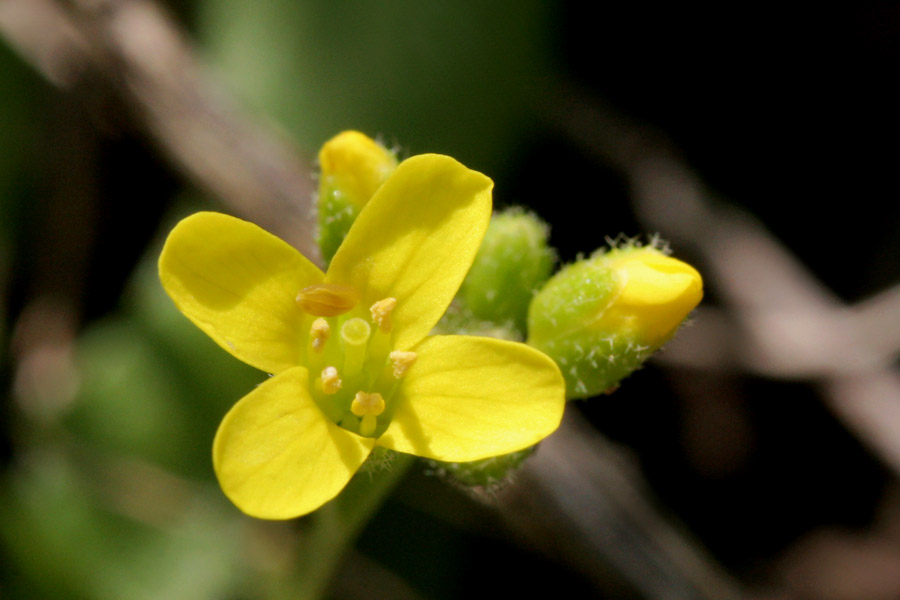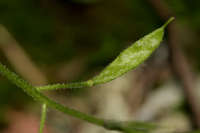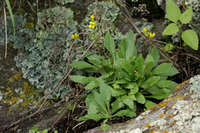
|
|
|
|
Family: Brassicaceae
Standley's draba, more...Standley's Whitlow-Grass, Standley's whitlowgrass
|
Perennials; (densely pulvinate); caudex branched (with persistent, thickened petioles, branches compact); not scapose. Stems unbranched, 0.3-1.3(-1.7) dm, usually glabrous throughout or sparsely pubescent proximally, rarely sparsely pubescent distally, trichomes simple and 2-rayed, 0.1-0.7 mm. Basal leaves (not imbricate); rosulate; petiolate; petiole ciliate, (trichomes usually simple, rarely 2-rayed, not setiform); blade narrowly oblanceolate to linear-lanceolate, (strongly differentiated into blade and petiole), (1.2-)1.8-6(-8.5) cm × 1-5(-7) mm, margins entire or sparsely denticulate, (ciliate as petiole; midvein not prominent), surfaces glabrous or pubescent, usually with simple trichomes 0.1-0.8 mm, rarely 2-rayed. Cauline leaves 1-8; sessile; blade lanceolate to narrowly oblong, margins usually entire, surfaces pubescent as basal. Racemes 5-17(-23)-flowered, ebracteate, elongated in fruit; rachis not flexuous, usually glabrous, rarely pubescent, trichomes simple and 2-rayed, (non-crisped). Fruiting pedicels divaricate-ascending or ascending, straight, 3-9(-13) mm, usually glabrous, rarely sparsely pubescent, trichomes simple. Flowers: sepals ovate, 2-2.5 mm, pubescent, (trichomes simple); petals yellow, oblanceolate, 4-6 × 1.5-2 mm; anthers oblong, 0.6-0.8 mm. Fruits linear-elliptic to elliptic, twisted or plane, flattened, 5-10(-13) × 1.5-2.5 mm; valves usually glabrous, rarely puberulent, trichomes simple, 0.05-0.1 mm; ovules 12-24 per ovary; style 0.7-1.4(-1.8) mm. Seeds ovoid, 1-1.2 × 0.7-0.8 mm. Flowering Jun-Aug. Igneous rock outcrops, stabilized talus slopes; of conservation concern; 1800-3100 m; Ariz., N.Mex., Tex. Draba standleyi is a distinctive species that is sporadically distributed in the mountains of southwestern United States. It is known from the Chiricahua Mountains (Cochise County, southeastern Arizona), the Organ Mountains and Black Range (Dona Ana and Sierra counties, south-central New Mexico), and the Davis Mountains (Jeff Davis County, western Texas). It has not been reported from Mexico, though it is very likely to occur there.
Martin and Hutchins 1980, Kearney and Peebles 1969 Duration: Perennial Nativity: Native Lifeform: Forb/Herb General: Tufted perennial, stems few, pubescent at base, glabrous above, 10-30 cm tall, very slender, erect to partially decumbent. Leaves: Mostly basal, narrowly oblanceolate to 8 cm long, 2-7 mm wide, toothed, ciliate with simple or forked hairs; cauline leaves elliptic, sessile but not auriculate, few-toothed. Flowers: Racemes much elongated with 5-20 flowers, sepals 2.5 mm long, petals yellow, 4-6 mm long, style 1-1.5 mm long. Fruits: Silicle ascending 8-13 mm long, glabrous. Ecology: Found on igneous rock faces, bases of cliffs, and clefts of porphyritic and andesitic rocks and soil from 5,000-8,500 ft (1524-2591 m) flowers June-August. Notes: Similar to both D. mogollonica and D. petrophilia, but differing in having very slender stems, its perennial nature, it is tufted with many fewer cauline leaves and very short styles. Distinctive also in its preferred habitat, that being moist igneous cliff sites. Ethnobotany: Unknown, but other species in the genus have uses. Etymology: Draba is from the Greek drabe for sharp or acrid, while standleyi is named for the American botanist Paul Standley (1884-1963). Synonyms: Dvraba chrysantha var. gilgiana O.E. Schulz; Draba gilgiana Wooton & Standl. Editor: SBuckley, 2010 |
This project was made possible in part by the Institute of Museum and Library Services [MG-70-19-0057-19].
Powered by Symbiota





